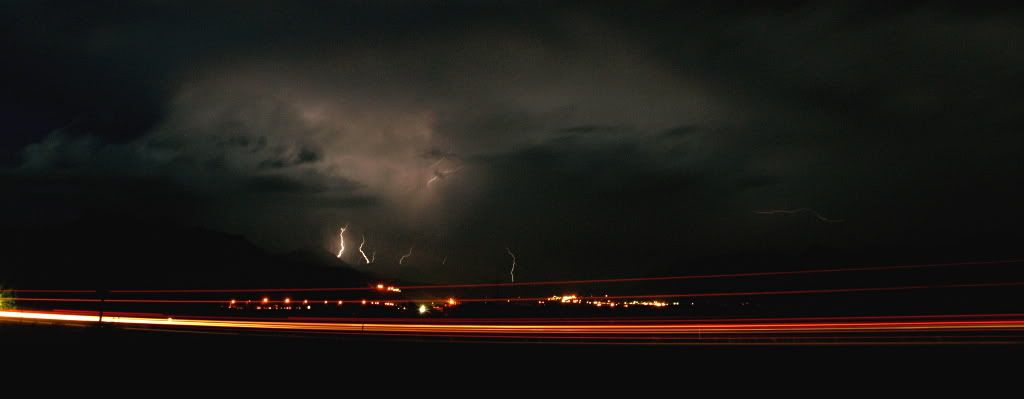Every Miles A Memory
Expedition Leader
If you've been following our blogs for any length of time, then you know how much we enjoy storm photography. I love trying to capture a passing storm especially when Mother Nature is throwing electrical currents through the air.
Up to this point, I've always relied on dumb luck to be able to catch the lightning bolts and I've been somewhat successful, or you could say really dumb and lucky. My technique was to simply turn the camera to manual focus after I had set the focus to where I wanted it. I would then point the camera in the direction of where the storm was and hold it tightly against my chest.
When ever I would see a flash of lightning, or anticipate another strike, I would start pressing the shutter button and hope I'd catch the bright white flash hitting the ground.
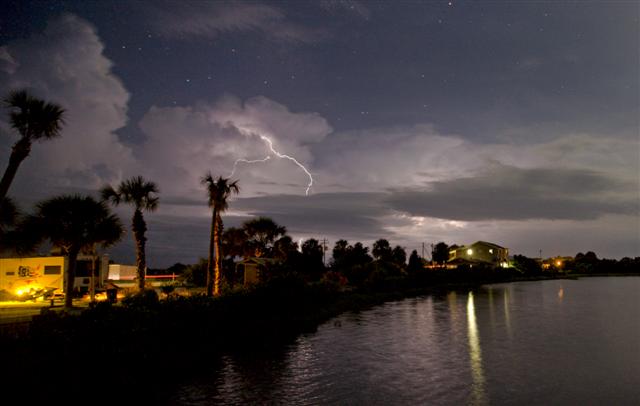
This usually resulted in hundreds of wasted images, but since its digital, it's not like I'm wasting anything other than my time, and the cameras shutter life.
Well a few weeks ago, after hours spent on the computer deleting images where I had missed the hundreds of lightning bolts we had watched pass the Low-Key Hideaway in one of our typical afternoon storms, I started looking for a lightning trigger.
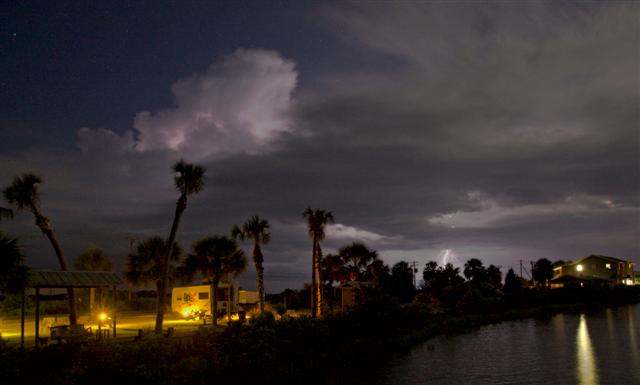
Up to this point, I had only dreamed of being able to afford one because they're way out of my price range. There is just no way I can afford a device that costs upwards of $500 when its something I'll only use for storm photography.
After doing a Google search and coming up with the typical over priced units I would normally find, I found a thread where photographers were talking about testing a new Lightning Trigger that had only recently hit the market, the AEO Lightning Trigger.
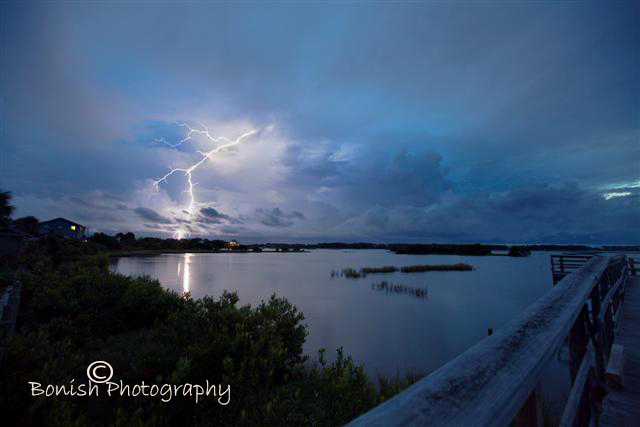
One of the Better Bolts I caught on this Test Run
They were all giving it glowing reviews and the price was what I thought was very affordable $130. Now that might seem steep if you live in an area where you get a good storm once or twice a year, but if you live in Florida like we do, then afternoon lightning storms are a daily occurrence. Something tells me I'll get some serious use out of this device this summer alone.
Tonight was the first time I got to use it and I was totally amazed. It was great to be able to set the controls on the camera to what I thought would be the right settings, you never really know because you cant predict how big the lightning bolts are going to be, but I set it up to what I thought would work, mounted the the Canon 5D atop my tripod, turned on the AEO Lightning Trigger, grabbed a glass of smooth red wine and sat out on the dock watching the storm pass.
The trigger is super sensitive and with any flicker of light in the clouds, it snaps the shutter. I realized right away that I was going to be deleting a ton of photos still because many of the lightning flickers were simply that, small flickers where you would never see a bolt come crashing through the clouds.
But what it allows the camera to do is capture the big bolts that I cant anticipate. This is where it's worth its weight in gold. Those are the ones I would usually miss or only catch half the strike. I'm not worried about deleting lots of wasted images, I can do that right on the cameras viewing screen, but anything that looks like it might be useable, I save and wait till I can look at the image on the larger computer monitor.
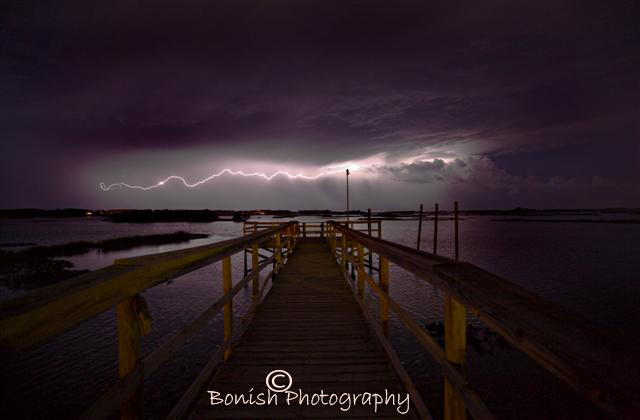
My Favorite Shot from the night - Cindy agrees it was money well spent!
I'm not all that interested in using photos of the clouds light up, I want a big, scary bolt of lightning spider webbing across the sky. Over the course of a few glasses of wine, where I was able to go back in the house to use the bathroom, apply more bug spray and talk with Cindy all the time leaving the camera doing it's work, I was very impressed with the device.
I did catch a few good images, but this is still the trial and error stage. I was changing my settings on the camera after every few shots because it seemed if I had it set on one setting, a huge bolt would come hitting the ground and completely blow out the frame due to being too bright for my current settings.
I'd change the settings and the next few bolts would be little tiny strikes that would leave the frame too dark to see anything other than the lightning strike.
So what I learned is I need to figure out a setting that will work no matter how big the lightning bolts are, and then I'll be able to simply leave the camera pointed in the right direction and watch the storm pass by.
Up to this point, I've always relied on dumb luck to be able to catch the lightning bolts and I've been somewhat successful, or you could say really dumb and lucky. My technique was to simply turn the camera to manual focus after I had set the focus to where I wanted it. I would then point the camera in the direction of where the storm was and hold it tightly against my chest.
When ever I would see a flash of lightning, or anticipate another strike, I would start pressing the shutter button and hope I'd catch the bright white flash hitting the ground.
This usually resulted in hundreds of wasted images, but since its digital, it's not like I'm wasting anything other than my time, and the cameras shutter life.
Well a few weeks ago, after hours spent on the computer deleting images where I had missed the hundreds of lightning bolts we had watched pass the Low-Key Hideaway in one of our typical afternoon storms, I started looking for a lightning trigger.
Up to this point, I had only dreamed of being able to afford one because they're way out of my price range. There is just no way I can afford a device that costs upwards of $500 when its something I'll only use for storm photography.
After doing a Google search and coming up with the typical over priced units I would normally find, I found a thread where photographers were talking about testing a new Lightning Trigger that had only recently hit the market, the AEO Lightning Trigger.
One of the Better Bolts I caught on this Test Run
They were all giving it glowing reviews and the price was what I thought was very affordable $130. Now that might seem steep if you live in an area where you get a good storm once or twice a year, but if you live in Florida like we do, then afternoon lightning storms are a daily occurrence. Something tells me I'll get some serious use out of this device this summer alone.
Tonight was the first time I got to use it and I was totally amazed. It was great to be able to set the controls on the camera to what I thought would be the right settings, you never really know because you cant predict how big the lightning bolts are going to be, but I set it up to what I thought would work, mounted the the Canon 5D atop my tripod, turned on the AEO Lightning Trigger, grabbed a glass of smooth red wine and sat out on the dock watching the storm pass.
The trigger is super sensitive and with any flicker of light in the clouds, it snaps the shutter. I realized right away that I was going to be deleting a ton of photos still because many of the lightning flickers were simply that, small flickers where you would never see a bolt come crashing through the clouds.
But what it allows the camera to do is capture the big bolts that I cant anticipate. This is where it's worth its weight in gold. Those are the ones I would usually miss or only catch half the strike. I'm not worried about deleting lots of wasted images, I can do that right on the cameras viewing screen, but anything that looks like it might be useable, I save and wait till I can look at the image on the larger computer monitor.
My Favorite Shot from the night - Cindy agrees it was money well spent!
I'm not all that interested in using photos of the clouds light up, I want a big, scary bolt of lightning spider webbing across the sky. Over the course of a few glasses of wine, where I was able to go back in the house to use the bathroom, apply more bug spray and talk with Cindy all the time leaving the camera doing it's work, I was very impressed with the device.
I did catch a few good images, but this is still the trial and error stage. I was changing my settings on the camera after every few shots because it seemed if I had it set on one setting, a huge bolt would come hitting the ground and completely blow out the frame due to being too bright for my current settings.
I'd change the settings and the next few bolts would be little tiny strikes that would leave the frame too dark to see anything other than the lightning strike.
So what I learned is I need to figure out a setting that will work no matter how big the lightning bolts are, and then I'll be able to simply leave the camera pointed in the right direction and watch the storm pass by.









